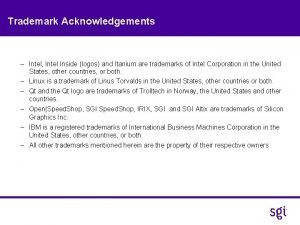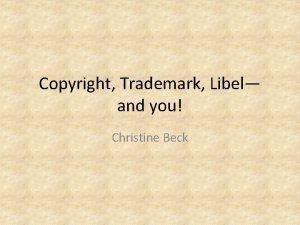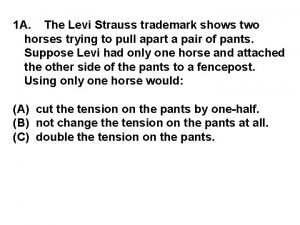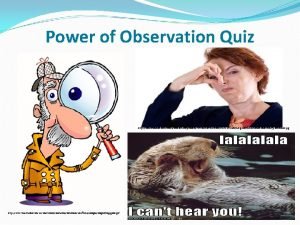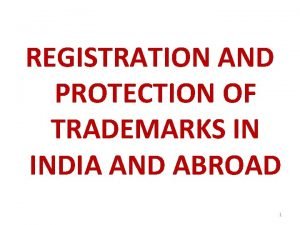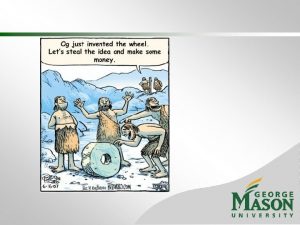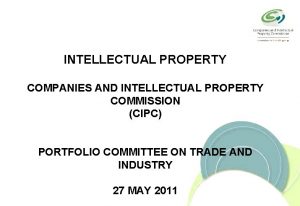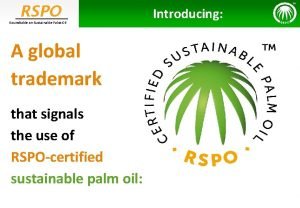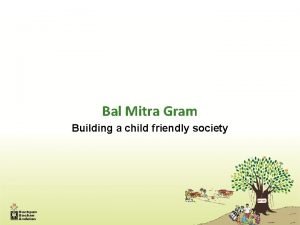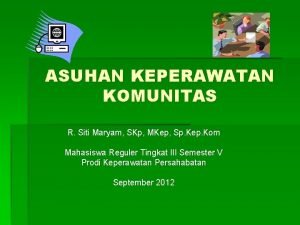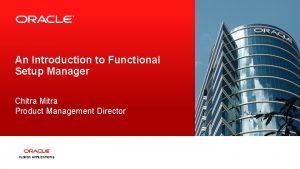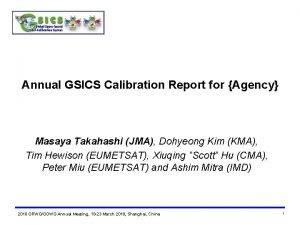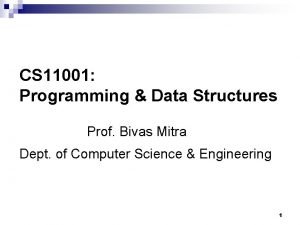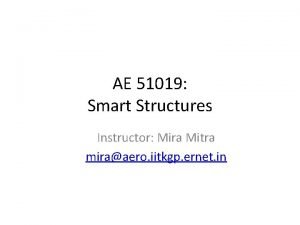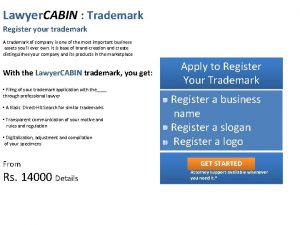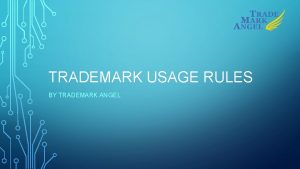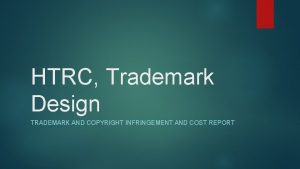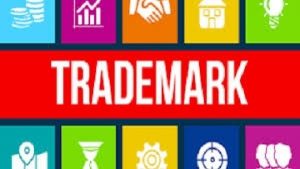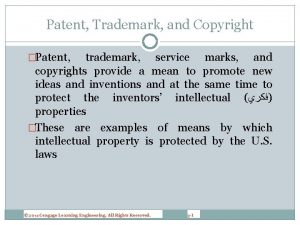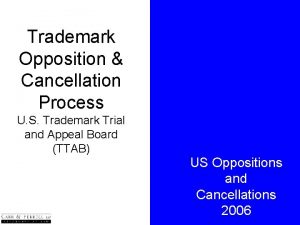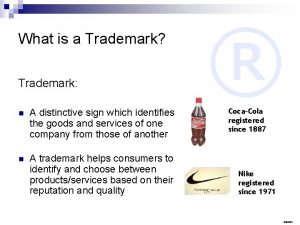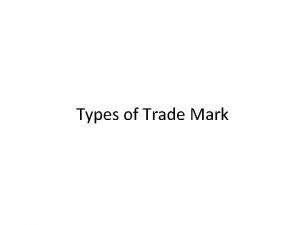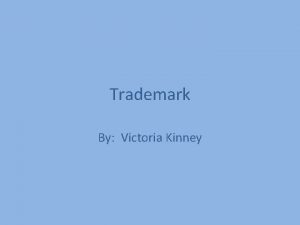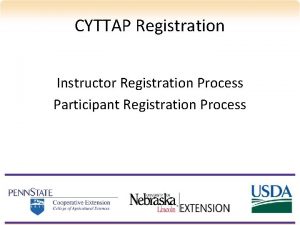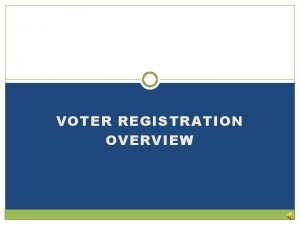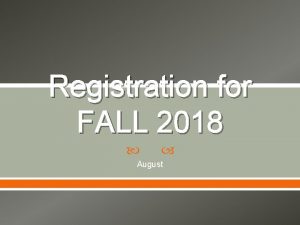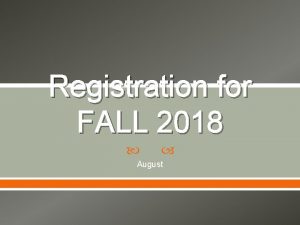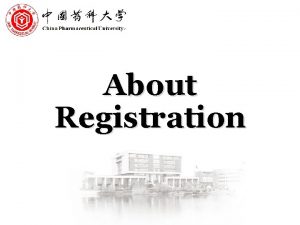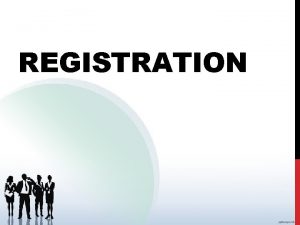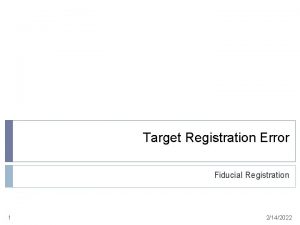Importance of Trademark Registration Dr S K Mitra





























- Slides: 29

Importance of Trademark Registration Dr. S. K. Mitra The Patent Office Kolkata. 1

What is a trade mark? A trade mark (popularly known as brand name) in layman's language is a visual symbol which may be a word, signature, name, device, label, numerals or combination of colours used by one undertaking on goods or services or other articles of commerce to distinguish it from other similar goods or services originating from a different undertaking The legal requirements to register a trade mark under the Act are: The selected mark should be capable of being represented graphically (i. e in the paper form) It should be capable of distinguishing the goods or services of one undertaking from those of others It should be used or proposed to be used mark in relation to goods or services for the purpose of indicating or so as to indicate a connection in the course of trade between the goods or services and some person have the right to use the mark with or without identity of that person 2

How to select a trade mark? Ø If it is a word it should be easy to speak, spell and remember Ø The best trade marks are invented words or coined words Ø Please avoid selection of a geographical name. No one can have monopoly right on it Ø Avoid adopting laudatory word or words that describe the quality of goods (i. e. best, perfect, super etc) Ø It is advisable to conduct a market survey to ascertain if same/similar mark is used in market 3

What is the function of a trade mark? Under modern business condition a trade mark performs four functions: q Identifies the goods / or services and its origin q Guarantees its unchanged quality q Advertises the goods/services q Creates an image for the goods/ services 4

Who can apply for a trade mark and how ? Any person claiming to be the proprietor of a trade mark used or proposed to be used by him may apply in writing in prescribed manner for registration. The application should contain the trade mark, the goods/services, name and address of applicant and agent (if any) with power of attorney , period of use of the mark and signature. The application should be in English or Hindi. It should be filed at the appropriate office 5

How to apply for a trade mark in respect of particular goods or services? It is provided under the Trade Marks Act, 1999 that goods and services are classified according to the International Classification of goods and services. Currently schedule IV of the Act provides a summary of list of such goods and services falling in different classes which is merely indicative. The Registrar is the final authority in the determination of the class in which particular goods or services fall. The Schedule IV of the Act indicates different classes of trade marks 6

What are different types of trade marks available for adoption? v Any name (including personal or surname of the applicant or predecessor in business or the signature of the person), which is not unusual for trade to adopt as a mark v An invented word or any arbitrary dictionary word or words, not being directly descriptive of the character or quality of the goods/service v Letters or numerals or any combination thereof v The right to proprietorship of a trade mark may be acquired by either registration under the Act or by use in relation to particular goods or service 7

v Devices, including fancy devices or symbols v Monograms v Combination of colors or even a single color in combination with a word or device v Shape of goods or their packaging v Marks constituting a 3 - dimensional sign v Sound marks when represented in conventional notation or described in words by being graphically represented 8

What purpose the trade mark system serves ? q Identifies the actual physical origin of goods and services. The brand itself is the seal of authenticity q Guarantees the identity of the origin of goods and services q Stimulates further purchase q Serves as a badge of loyalty and affiliation q Enable consumer to make a life style or fashion statement 9

Who benefits from a trade mark? Ø Regd. Proprietor: Regd. Proprietor of a trade mark can stop other traders from unlawfully using his trade mark, sue for damages and secure destruction of infringing goods and or labels Ø Legal professionals: The Trade Marks Registration system is driven by professionals and legal and para legal advisors (Agents) who act for the clients in the processing of the trade marks application Ø Purchaser and ultimately Consumers getting benefit of trade marks for goods and services 10

What are the benefits of registering a trade mark? The registration of a trade mark confers upon the owner the exclusive right to the use of the registered trade mark and indicate so by using the symbol (R) in relation to the goods or services in respect of which the mark is registered and seek the relief of infringement in appropriate courts in the country. The exclusive right is however subject to any conditions entered on the register such as limitation of area of use etc. Also, where two or more persons have registered identical or nearly similar mark due to special circumstances such exclusive right does not operate against each other 11

What are the formalities and government fees for major trade mark transaction ? v Filing new applications there are prescribed forms depending on the nature of application such as Form TM-1, TM-2, TM-3, TM-8, TM-51 etc. Fees: Rs. 2, 500/- v Filing a Notice of Opposition to oppose an application published in the Trade Marks Journal (Form. TM-5) Fees: Rs. 2, 500/- v Renewal of a Regd. trade mark (Form TM-12 ) Fees: Rs. 5, 000/- v Surcharge for belated renewal (Form -10) Fees: Rs. 3, 000/12

v Restoration of removed mark (Form TM-13) Fees: 5, 000/v Application for rectification of a registered trade mark (Form TM-26) Fees: Rs. 3, 000/v Legal Certificate (Form TM-46) Providing details of entries in the Register Fees: Rs. 500/- v Official search request (Form TM-54) Fees: Rs. 500/v Preliminary advise of the Registrar as to the registrability of a mark (Form TM-55) Fees: Rs. 500/v Copyright search request & issuance of certificate (Form TM-60) Fees: Rs. 5, 000/13

What are the sources of trade mark laws? (1) The national statue i. e. , the Trade Marks Act, 1999 (2) and rules thereunder (2) International multilateral convention (3) National bilateral treaty (4) Regional treaty (5) Decision of the courts (6) Office practice and rulings (7) Decision of Intellectual Property Appellate Board (8) Text books written by academician and professional experts 14

What does the Register of trade mark contain ? The register of trade mark currently maintained in electronic form contains interalia the trade mark the class and goods/ services in respect of which it is registered including particulars affecting the scope of registration of rights conferred; the address of the proprietors; particulars of trade or other description of the proprietor; the convention application date (if applicable); where a trade mark has been registered with the consent of proprietor of an earlier mark or earlier rights 15

Can any correction be made in the application or register? Yes. The basic principle is that the trade mark applied for should not be substantially altered affecting its identity. Subject to this changes are permissible according to rules detailed in the subordinate legislation Can a registered trade mark be removed from the register? Yes. It can be removed on application to the Registrar on prescribed form on the ground that the mark is wrongly remaining on the register. The Registrar also can suo moto issue Notice for removal of a registered trade mark 16

J U R I S D I C T I O N Mumbai Trade mark Registry Maharashtra, Madhya Pradesh & Goa Ahmedabad Trade mark Registry Gujarat, Rajasthan & the Union Territories of Daman, Diu, Dadra & Nagar Haveli Chennai Trade mark Registry Andhra Pradesh, Kerala, Tamil Nadu, Karnataka, Pandichery & Lakshadweep Kolkata Trade mark Registry Arunachal Pradesh, Assam, Bihar, orissa, West Bengal, Manipur, Mizoram, Meghalaya, Sikkim, Tripura, Nagaland, Andaman & Nikobor Delhi Trade mark Registry Jammu & Kashmir, Punjab, Haryana, U. P. , Himachal Pradesh, 17 Delhi & Chandigarh

What is a trade mark? A trade mark (popularly known as brand name) in layman's language is a visual symbol which may be a word signature, name, device, label, numerals or combination of colours used by one undertaking on goods or services or other articles of commerce to distinguish it from other similar goods or services originating from a different undertaking The legal requirements to register a trade mark under the Act are: v The selected mark should be capable of being represented graphically (i. e in the paper form) v It should be capable of distinguishing the goods or services of one undertaking from those of others v It should be used or proposed to be used mark in relation to goods or services for the purpose of indicating or so as to indicate a connection in the course of trade between the goods or services and some person have the right to use the mark with or without identity of that person 18

SONY OLYMPUS TRADEMARKS (Governed By The Trade Marks Act, 1999) • A trade mark is any sign which can distinguish the goods of one trader from those of another. Sign includes, words, logos, pictures, or a combination of these. • A trade mark is used as a marketing tool so that customers can recognize the product of a particular trader. • To register a trade mark , the mark must be: distinctive, and, not deceptive, or contrary to law or morality, and, not identical or similar to any earlier marks for the same or similar goods. 19

TRADE MARKS 20

JAPANESE PATENT OFFICE REPORT - + 6. 2 TRILLION YEN - +3. 1 TRILLION YEN - +1. 9 TRILLION YEN SOME OTHER WELL KNOW MARKS 24 HR CHANNEL; PACKAGE DELIVERY COMPUTERS 21

TRADEMARKS • India affords full protection to trade marks under the Trade Marks and Merchandise Act. The Indian law of trademarks is protected by the Trade & Merchandise Marks Act, 1958. A new statute i. e. the Trade Mark Act, 1999 has been enacted in India to bring it in conformity with the TRIPs Agreement, to which India is a signatory. Indian Trademarks Act, 1999, came into force on September 15, 2003. • India has made a step towards fulfilling its international obligations. Consequently, the Indian trademark law has now become fully compatible with the International standards laid down in the TRIPs Agreement. The New Act primarily consolidates and amends the old Trade & Merchandise Marks Act, 1958 and provides for better protection of goods and services 22

TECHNICAL ADVANCEMENT BY WAY OF A NEW PRODUCT OR A NEW PROCESS NOT LIMITED TO OUTER VISUAL APPEAL KEEP IT SECRET DISCLOSE TO OTHERS 23

& Secret Commercial Value Steps Taken To Keep It Secret 24

A typical example is Coca-Cola. This soft drink was invented in 1886 and was never protected by a patent, only by a trademark (for the name Coca-Cola) and by an industrial design (for this very special design of the Coca-Cola bottle, supposed to be in the shape of a woman wearing a long skin-tight dress). The process of the Coca-Cola drink is secret and is only known by two persons in the world. They are not allowed to travel together, so that there is no chance of them dying at the same time in an accident. The secret of the Coca-Cola process was well kept during all these years, and nobody is able to produce a drink with exactly the same taste still today. You all know that Pepsi Cola, its 25 biggest competitor, has a different taste.

FOR MOST PRODUCTS EVERY FORM OF INTELLECTUAL PROPERTY RIGHTS CAN BE OBTAINED CAMERA “PATENT” For every individual improved mechanism “DESIGN” For outer shape & Contour / Configuration “TRADE MARK” Brand name or Logo for goods denoted as ® “Copy right” For Instruction / manual booklet denoted as © 26

CD PLAYER Industrial design protection for 3 D shape Brand nameregistered under trademark Music played on the CD player is protected by copyright Various technical parts & mechanisms are subject mater of protection under Patents 27

v. DIFFERENTIATES YOUR PRODUCTS AND SERVICES FROM OTHERS v. PROMOTES YOUR PRODUCTS AND SERVICES AND CREATES A LOYAL CLIENTELE v. DIVERSIFIES YOUR MARKET STRATEGIES TO VARIOUS TARGET GROUPS v. POPULAIZES YOU IN FOREIGN COUNTRIES v. KEEPS AWAY YOUR COMPETITORS/COPIERS 28

THANKS 29
 Intel inside trademark
Intel inside trademark Trademark
Trademark The levi strauss trademark shows two horses
The levi strauss trademark shows two horses Fsc trademark
Fsc trademark Boeing company profile
Boeing company profile On which playing card is the cardmaker's trademark
On which playing card is the cardmaker's trademark Features of trademark
Features of trademark Trademark and trade secret
Trademark and trade secret Cipc patent journal
Cipc patent journal Rspo trademark license
Rspo trademark license Que es mitra en la biblia
Que es mitra en la biblia Bal mitra gram
Bal mitra gram Tulika mitra
Tulika mitra Mitra rocca
Mitra rocca Mitra päähine
Mitra päähine Model komunitas sebagai mitra
Model komunitas sebagai mitra Rito mitra
Rito mitra Pt among otista raya
Pt among otista raya Subarna mitra
Subarna mitra Chitra mitra
Chitra mitra Ashim mitra
Ashim mitra Bivas mitra
Bivas mitra Mitra janes
Mitra janes Mitra nejad
Mitra nejad Entanglement witness
Entanglement witness Mitra kazemi
Mitra kazemi Dr debasis mitra
Dr debasis mitra Envigo
Envigo Mira mitra iit kgp
Mira mitra iit kgp Dr rito mitra
Dr rito mitra
